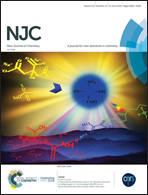Heavy atom free 1,1,4,4-tetraphenylbuta-1,3-diene with aggregation induced emission for photodynamic cancer therapy†
Abstract
Common organic molecules usually suffer from aggregation caused quenching (ACQ), which is disadvantageous for imaging guided phototherapy. It is of tremendous significance for a photosensitizer to be well soluble and simultaneously remain highly fluorescent in aqueous solution. Heavy atom free 1,1,4,4-tetraphenylbuta-1,3-diene (denoted as TPD) with aggregation induced emission (AIE) was designed and synthesized by the Knoevenagel reaction. 1,2-Distearoyl-sn-glycero-3-phospho-ethanolamine-N-[methoxy(polyethyleneglycol)-2000] (DSPE-PEG-2000) coated TPD nanoparticles (NPs) show high singlet oxygen generation ability with singlet oxygen sensor green (SOSG) as a probe and still remain highly fluorescent in aqueous solution. In vitro cytotoxicity assay demonstrates that these NPs have a half-maximal inhibitory concentration (IC50) as low as 8.2 μg mL−1. Meanwhile, in vivo fluorescence imaging shows that these NPs can passively target the tumor by the enhanced penetration and retention (EPR) effect within 6 h. Furthermore, in vivo phototherapy suggests that TPD NPs are able to inhibit the growth of a tumor after irradiation without side effects on the normal tissues, including heart, liver, spleen, lungs and kidneys, indicating the low dark toxicity, high phototoxicity and excellent bio-compatibility of such NPs.



 Please wait while we load your content...
Please wait while we load your content...